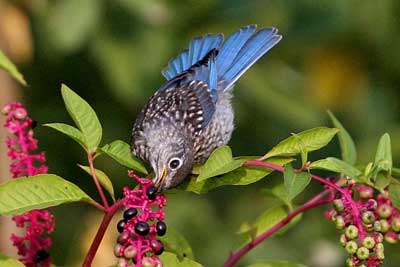Also see Planting for Bluebirds | Suet Recipes | Feeding Mealworms | Supplementing Calcium | Invasive Plants to Avoid

What bluebirds eat depends in part on what is available.
Back in the day, when bluebirds were more plentiful and permits weren’t required to dissect them, people analyzed the contents of their stomachs to figure out what they were consuming. On average, they learned that, over the seasons, about 68% of a bluebirds’ diet is made up of insects: grasshoppers, crickets, beetles, spiders, and caterpillars (Beal 1915).
They also eat ants, wasps and bees, flies, Myriapods, angleworms (Oligochaetest), snails, sow bugs (Isopodan), and black olive scales (Homoptera), moths, weevils and termites. (BNA).
Prey is usually spied from a perch and then caught on the ground. Occasionally they catch insects in flight, especially when its warmer and flying insects are abundant. Mountain Bluebirds tend to “hover-forage” more than Western or Eastern.
But during nesting season, the proportion of insects in the food bluebirds collect is probably significantly higher than 68%. That is because their growing young need lots of protein.
One researcher found that bluebird parents primarily fed their nestlings caterpillars (32.4%) followed by Orthoptera like grasshoppers (25.6%) and spiders (11.3%) (Pinkowski 1976). Occasionally; larger nestlings are fed earthworms, however this may cause severe diarrhea.
The rest of a bluebird’s diet is mostly small fruit -e.g., flowering dogwood, holly, mulberry, wild grape, Virginia creeper, pokeweed, and Viburnum, gleaned from plants or foraged on the ground. (Although they will eat the fruit of multiflora rose and Japanese honeysuckle, these are invasive species, and should be eradicated.) It’s a good idea to plant native fruit-bearing shrubs and trees to help bluebirds have a varied diet, and to assist when insects are scarce.
Occasionally they may eat vertebrates: small snakes, salamanders, tree frogs and lizards. (BNA). There is even an observation of a bluebird eating a shrew. (Pinkowski 1973) Larger prey (e.g., vertebrates) or insects with hard exoskeletons may be bashed against the ground or a perch before consumption.
Bluebirds rarely eat birdseed, although they will occasionally take shelled sunflower, safflower and peanut chips/nut meats. Seeds in fruit they consume will pass through their system undigested. If bluebirds are seen at a bird feeder, they may also be seeking out insects/larvae in the seed, or dried fruits or nut meats mixed with seed.
Bluebirds can be trained to eat suet (see link for recipes). I find homemade crumbly-style peanut butter suet is preferred over store-bought mixtures.
Bluebirds do love mealworms, but overfeeding them can cause calcium deficiency. So if you do offer mealworms, do it as an occasional treat, or during bad weather or for a widower, and limit quantities to no more than 15 mealworms per day, per bird. I avoid feeding dried mealworms from China, as they offer no moisture to baby birds, and who knows what foods or additives they were raised on. But nothing beats a natural diet. Read more.
The best thing you can do to help bluebirds have a healthy, varied diet is to landscape with native plants that produce berries throughout the seasons, and avoid using pesticides (which kill insects and can harm or kill birds), and place nestboxes in the right habitat for hunting. Eastern bluebirds prefer semi-open grassland habitat, such as mowed meadows, large lawns, cemeteries, orchards, roadsides, and areas with scattered trees and short ground cover. Areas with fence lines, some medium size trees, or telephone lines provide perches for hunting and nest-guarding. Western Bluebirds tend not to favor large, open meadows.
More Information and References:
- Planting for bluebirds
- Suet and suet recipes
- Feeders
- Fecal glue that may be caused by feeding earthworms
- Feeding Mealworms
- Raising Mealworms
- Supplementing Calcium – feeding crushed eggshells
- Migratory Bird Treaty Act – This law did not go into effect until 1918. It prohibits collection of native birds without a permit.
- Guinan, Judith A., Patricia A. Gowaty and Elsie K. Eltzroth. 2008. Western Bluebird (Sialia mexicana), The Birds of North America Online (A. Poole, Ed.). Ithaca: Cornell Lab of Ornithology; Retrieved from the Birds of North America Online: doi:10.2173/bna.510
- For those who want to reduce the use of pesticides, starting a bluebird trail in agricultural areas like vineyards can be a great addition to an Integrated Pest Management Plan (which minimizes the use of chemicals and relies more on natural alternatives.)
- Eastern Bluebird hunting behavior
– Frank G. Ashbrook, The Green Book of Birds of America, 1931
